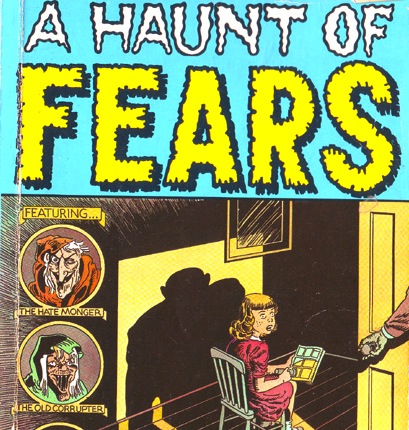Séminaire doctoral interuniversitaire “Nouvelles perspectives pour la recherche en bande dessinée”
Gothic and Comics: From A Haunt of Fears to a Haunted Medium
a conference by Julia Round (Bournemouth University)
Friday 12 March 2017 at 4 PM
Universiteit Gent
Auditorium A (Blandijnberg)

Detail from the cover for Martin Barker’s « A Haunt of Fears: The Strange History of the British Horror Comics Campaign » (Pluto Press, 1984)
Gothic contains many paradoxes. It repels but attracts; it horrifies but fascinates. Its literature has been reviled but is also canonised. Its archetypes break borders and transgress boundaries. We recoil from sights of horror, but expand our senses in the presence of terror. Gothic culture is introspective and introverted, but simultaneously performative and confrontational.
Comics are also about hybridity and tension (Hatfield 2005). They range from funny animal stories to the darkest graphic reads, and often contain awareness of both. The page combines word and image; the reader becomes the author, adding and interpreting events. Comics fans are dynamic and imaginative creators and collaborators (cosplay, fanzines) but also some of the most extreme consumers and collectors (merchandise, ‘slabbing’).
This talk will use a series of case studies to argue that comics can be considered Gothic in historical, thematic, cultural, structural and formalist terms. Although the most obvious connection between comics and Gothic takes us to 1950s America and the horror comics scandal, this is just the beginning. I will look first at the thematic presence of Gothic in other subgenres, including the superhero, the autobiographical, and children’s anthologies. It will then proceed to demonstrate parallels between comics and goth culture. I will argue that both use processes of duality and inversion to function through processes of exclusion and separation. Shared elements include the presentation of an outward-facing coherence that masks strong opposed internal subgroups; a requirement for active participation from members; a reliance on commodity and consumption; and a strong sense of community revolving around clubs and conventions.
Finally, it focuses on the formal qualities of the comics medium. It argues that many points of comics narratology can be rearticulated using gothic literary theory. It looks closely at the spatial layout of the page and the depiction of time as space, the active role of the comics reader in the gutter, and the mobility of visual and verbal perspective. It reconsiders these areas using the gothic tropes of haunting, the crypt, and of excess: demonstrating that a haunted page, a revenant reader, and an aesthetic of excess underpin comics’ narratology.
Julia Round (MA, PhD) is a Principal Lecturer in the Faculty of Media and Communication at Bournemouth University, UK, and co-edits the academic journal Studies in Comics (Intellect). Her research and teaching interests include gothic, comics, adaptation and children’s literature. She has recently published a monograph entitled Gothic in Comics and Graphic Novels: A Critical Approach (McFarland, 2014) and the co-edited collection Real Lives Celebrity Stories (Bloomsbury, 2014). For further details please visit www.juliaround.com.
Organized by Maaheen Ahmed (CMSI, UGent)
